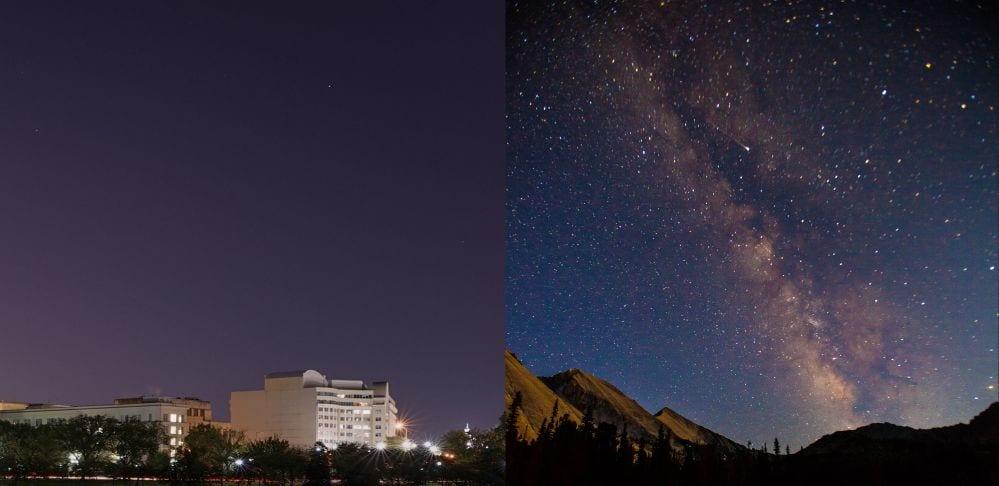
09 Nov How Americans lost the stars and how we might be able to get them back- Sam-H-A and Ed Cannady Photos
The United States is poised to get its first Dark Sky Reserve under the pristine nighttime skies of central Idaho. Pending approval from the International Dark-Sky Association, the designation would recognize the region’s clear skies, virtually untouched by light pollution, as “possessing an exceptional or distinguished quality of starry nights and nocturnal environment.”
If you’ve lived in or near cities most of your life and have never seen a truly dark sky you may not understand why anyone would bother with this. The night is dark, and dark is dark wherever you are, right?
Not exactly. The best way to explain what the Idaho Dark Sky Reserve backers want to preserve is to show it visually. Below are two photographs: on the left, a shot of the night skies in Washington, D.C. On the right, the sky above Idaho’s White Cloud mountains, which would make up part of the proposed reserve.
If you squint real hard you can make out one, maybe two stars in the photo on the left. On the right there are hundreds, perhaps thousands, with millions more casting their unearthly glow through the gas and dust clouds of our own Milky Way galaxy — the streak of nebulous light traversing the photo diagonally.
Why can’t you see the Milky Way from the D.C.? Light pollution: Streetlights and security lights and lit-up buildings contribute to a massive dome of purple-grey haze that washes out all but a handful of the brightest stars. The farther away you get from city centers, the more of the night sky you can see. But in densely populated areas like the East Coast, you need to travel hundreds of miles before you reach truly unpolluted skies.
Because so much of what we can see from space is incredibly faint, at the edge of human perception, the effect of even a small amount of ambient light on the night sky can be dramatic. Below, for instance, is a simulation of the same slice of night sky viewed through different levels of light pollution.
When light pollution is low, you can make out the structure of the Milky Way and even view some deep-space objects, like galaxies and nebulae, with the naked eye. Viewing the night sky is like looking out not just across space, but across time as well. The Andromeda Galaxy, for instance, is 2.5 million light-years away — the light we see from it was emitted long before the first modern humans walked on Earth. You can actually see it without a telescope, but not if you’re anywhere near a city.
Paradoxically, the darkest night skies appear filled with light. Under the right conditions, the Milky Way even appears bright enough to cast a faint shadow.
Before the widespread adoption of electric lighting, these night-sky riches were accessible to just about anyone living anywhere. “Less than 100 years ago, everyone could look up and see a spectacular starry night sky,” the International Dark-Sky Association writes. “Now, millions of children across the globe will never experience the Milky Way where they live.”
That’s where places like the proposed Dark Sky Reserve in Idaho come in. “When we lose the night sky, we lose a piece of ourselves,” said Dani Mazzotta of the Idaho Conservation League. “Being able to look into the cosmos, look past the earth, look into the heavens, that is a really strong, profound experience.”
Mazzotta’s been working on the Dark Sky Reserve designation with central Idaho communities for two years. The reserve would encompass roughly 900,000 acres in central Idaho. Most of it is public land owned by the U.S. Forest Service. A key requirement of the designation is that communities within the reserve’s boundaries, like Ketchum and Sun Valley, commit to minimizing their own light pollution. Most of those communities already have light pollution ordinances in place, Mazzotta said, making the region an ideal location for the country’s first Dark Sky Reserve.
The communities within the reserve hope they can capitalize on the designation economically, via “astro-tourism.” “Most people when they come here from a place without dark skies, they look up and they’re just like ‘wow, this is phenomenal,'” Mazzotta said. She points to existing dark sky festivals in places like Jasper, Canada and Lassen Volcanic National Park as potential models for what central Idaho could do.
There’s certainly a large potential market for it. Nearly 80 percent of people living in North America are unable to see the Milky Way from where they live, according to a 2016 study that mapped the extent of global light pollution. Starting with satellite measurements of ground-based light emissions, a team of earth scientists and astronomers applied a sophisticated algorithm to measure how that light bounced and refracted through the atmosphere, washing out the night sky to observers on the ground.
Here, for instance, is the map of light pollution across the United States. Blacks and greys indicate pristine and near-pristine skies. Light pollution then runs up the rainbow gamut of colors, from blue to red, and finally pink and white designate extreme light pollution in places like city centers.
Zooming into the East Coast, you can see that there’s an almost unbroken swath of white and pink running from New York to D.C. From Washington, the closest truly dark skies are over 600 miles away in Algonquin Provincial Park, Ontario.
Long story short? Where there’s people, there’s light. And where there’s too much light, the night sky is lost to us.
If you can’t make it to central Idaho any time soon, that light pollution map is a good way to find nearby places that offer skies darker than what you’re used to. Dark sky advocates say the experience is well worth the trip if you have to make one.
“Before we devised artificial lights and atmospheric pollution and modern forms of nocturnal entertainment we watched the stars,” astronomer Carl Sagan wrote in his book “Pale Blue Dot.” “Even today the most jaded city dweller can be unexpectedly moved upon encountering a clear night sky studded with thousands of twinkling stars. When it happens to me after all these years it still takes my breath away.”
By: Christopher Ingraham

